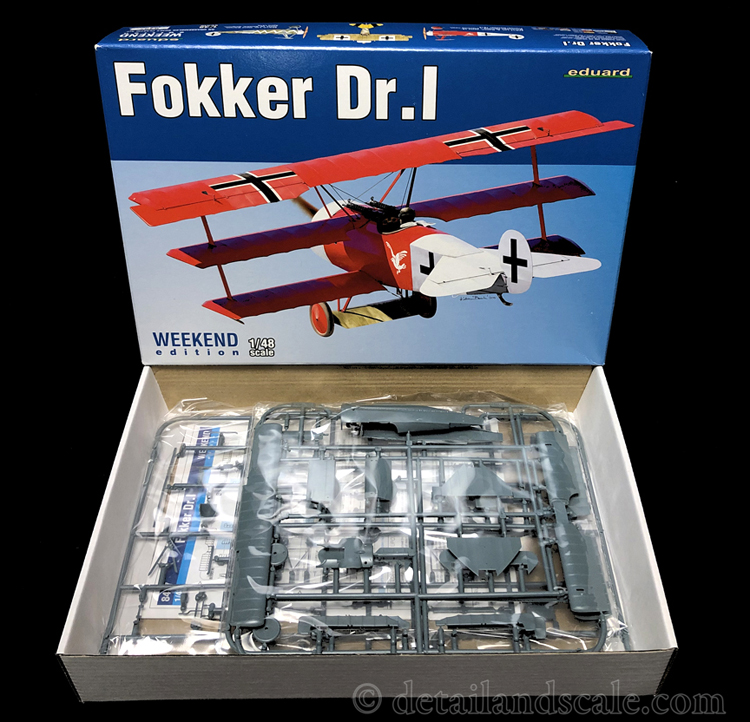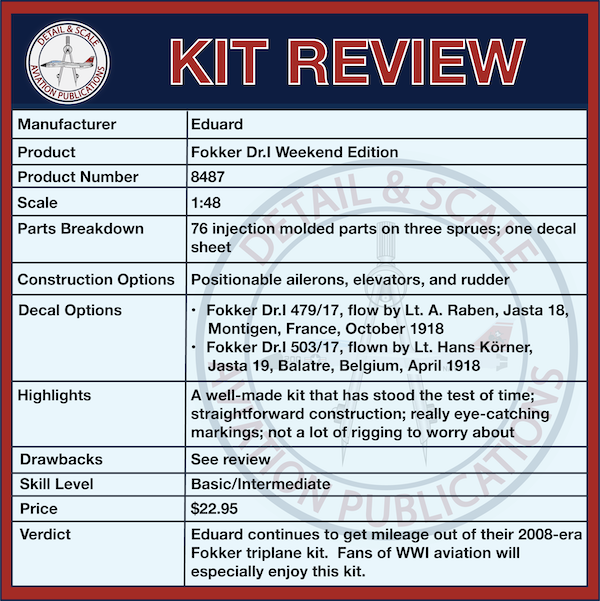Eduard Fokker Dr.I Weekend Edition
1:48 Scale


Within the span of 15 years, aircraft design and engineering evolved considerably from the fledgling Wright Flyer to deadly combat aircraft. Yet, the optimal balance between structures, powerplants, weight, and aerodynamics was still very much a work in progress. Towards the end of the war, the Fokker Triplane, the Dr. I, made its debut over the war-torn skies of Europe. In this recent release, Eduard has re-popped their 1:48 scale injection-molded Fokker Dr. I from their original 2008 tooling as a Weekend Edition kit. Let’s check it out.

In February 1917, the Sopwith Triplane made its first appearance in combat, and it soon demonstrated it was superior to the more heavily armed Albatros. Not long after, the Germans began to rapidly design and develop their own triplane with Fokker-Flugzeugwerke in the lead. By July, a prototype was flying and at the end of August, the fledgling Fokker triplane, or dreidecker, entered into combat trials. Baron von Richthofen flew some of these early operational flight tests and shot down two opposing aircraft in the process. His report enthusiastically lauded the new plane, and described the Dr. I as superior to the Sopwith Triplane. The German ace-of-aces scored his last 19 kills in the type and was shot down flying a Dr. I in April of 1918.
When compared to the Albatros and Pfalz fighters, the Dr.I was far more maneuverable (reflecting its relatively greater aerodynamic instability) and was capable of what today might be called “bat turns.” At the same time, its maximum speed of 100 MPH was slower than most Allied fighters and it did not perform well at higher operational altitudes. In service, chronic structural problems led to numerous examples of wing failures. Despite its promise, production ended in May 1918 at which point only 320 airframes had been produced. Dr. Is were withdrawn from front line action and reassigned to training and home defence units. Following the end of the war, only three Dr. Is survived, though various modern replica versions of the infamous triplane fighter exist today.

Eduard’s 1:48 scale Fokker Dr.I Weekend Edition kit comes on three injection-molded polystyrene sprues containing 76 parts. About 68 of them get used in this version of the kit. The color instruction booklet organizes the build over nine pages. Markings for two airplanes are included:
- Fokker Dr. I 479/17, flow by Lt. A. Raben, Jasta 18, Montigen, France, October 1918
- Fokker Dr. I 503/17, flown by Lt. Hans Körner, Jasta 19, Balatre, Belgium, April 1918
Strengths: This kit might be based on an “older” mold by Eduard, but their late 2000s work was quite good and foreshadowed the quality of kits that Eduard produces today. I would argue that this kit itself is pretty simple but not necessarily simplified. I find it to be overall quite accurate. There are not a lot of parts, fit is quite good, and surface detail is excellent for a 1:48 scale WWI-era aircraft. I think this kit will appeal to a wide range of scale modelers since there’s almost no rigging to worry about with the Dr. I. The ailierons, elevators, and rudders are all separate parts and can be positioned as desired.
The cockpit is a highlight, even without any detail parts. You get the cockpit sidewall tubular framing, a good pilot’s seat, and the control column and rudder pedals among other details. In typical “Weekend Edition” fashion, the shoulder harnesses and lap belts are provided as decals as is the centrally placed altimeter dial face. For injection molding, the engine and machine guns look quite nice.
The decals were printed in-house by Eduard they look great in terms of color, register, and opacity. Carrier film is thin and tightly restrained.
Weaknesses: I cannot offer any deeply substantive critiques of this kit. One minor issue involves the fact that instrument panel appears to be…blank. There should be a small bank of instruments on the front of Part B6 but they are absent. I’m not sure what’s up with that – . Also note that you’ll have to fabricate your own dial face attached to Part C39 before you can place the instrument dial face decal on anything.

Eduard continues to get mileage out of their solid Fokker Dr. I. It’s a genuinely nice kit. Fans of WWI subject matter will really enjoy this issue of the kit, and its relative simplicity, nice detail, and markings options, I feel, really extends an invitation to a wide range of scale modelers.
Sincere thanks are owed to Eduard for the review sample. You can visit them on the web at http://www.eduard.com and on Facebook at https://www.facebook.com/EduardCompany
Haagen Klaus
Scale Modeling News & Reviews Editor
Detail & Scale


